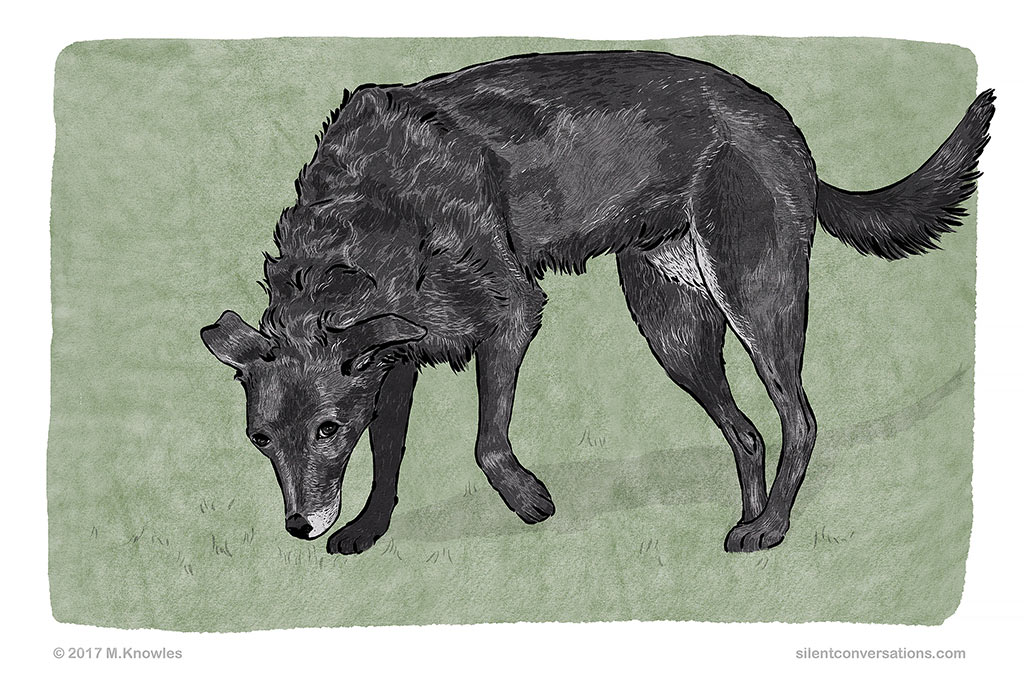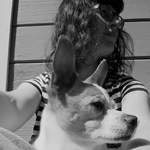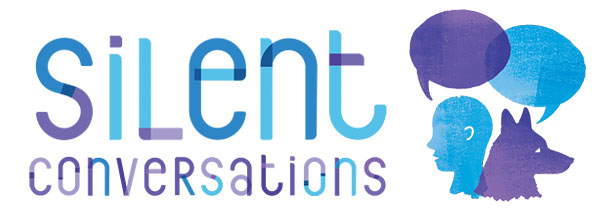
Sniffing the ground – Dog Body Language
Dogs may sniff the environment often to investigate scents, but with careful observation and awareness of context, it becomes apparent when sniffing is part of dog communication. It is so subtle the communication can go unnoticed at times.
Sniffing can be used as a calming signal when an interaction is too intense. One dog may start to walk away, slowly sniffing the ground; the other dog may mirror him by also sniffing the ground. This is a good way to defuse an interaction.
Sniffing can be used as negotiation as two dogs approach each other; a deliberate slower approach is polite when greeting. Sniffing the ground is commonly used as part of the body language signals offered at the beginning stages of an approach.
In other contexts, sniffing could also be interpreted as displacement behaviour or a stress response. A dog may feel conflicted about something he sees ahead of him; he may slow down and stop to sniff the environment. Sniffing may help displace the anxiety, and it gives the opportunity to assess things further from a safe distance by stalling the approach.
Here are a couple of examples of situations where a dog may start sniffing the ground:
-
A woman is walking her dog in a suburban neighbourhood. Up ahead on the pavement, a group of people is walking towards them. At a distance from the approaching people, the dog looks up. His mouth closes, his ears are forward, his tail is up, and he starts slowing and pauses for a second, whilst lifting his paw ever so slightly. The dog slows even more, curves slightly, stops, and seems very interested in suddenly sniffing a bush. This sniffing could be occurring because the dog may feel uncomfortable with the crowd of people approaching. This may be slight displacement due to his feeling a bit anxious or unsure. Read further about the dog’s perspective of head-on approaches in ‘Considering the effects of walking or running straight towards a dog‘.
-
In an off lead area, two dogs approach one another. They are quite a distance apart. As they start walking towards each other, both slow their pace on approach. One dog starts sniffing the ground as he slowly proceeds forward. The other dog responds by pausing and doing a head turn, and then she slowly starts curving her approach. The first dog continues to approach slowly, and he intermittently sniffs the ground. As they both near each other, they curve their bodies ever so slightly, pausing for a few seconds. He keeps his head up, his ears are a little to the side and up, his tail is ever so slightly raised, and it wags slowly. He now offers a head turn. She reciprocates with a head turn, her ears are to the side slightly, and her tail is wagging slowly in line with the height of her back. They slowly curve round each other and sniff behind. Then they slowly curve away. He starts sniffing the environment nearby; she follows and sniffs a bit too. They then move away from each other and go their separate ways. Sniffing the ground was used as a calming signal and part of the negotiation on approach. Each dog takes time to approach, and they start the conversation a distance away, responding with appropriate signals.
-
A person is trying to call her dog back to her in the park. Her dog does not come immediately, so she calls her dog again, this time with obvious frustration in her voice. Her dog slows even more, then stops and sniffs the ground. The dog, noticing his guardian’s frustration in the tone of voice and agitated body language, may be offering a calming signal to his guardian or may be showing some displacement due to pressure.
-
Two dogs have just greeted each other. The one dog is a bit invasive and persistent with sniffing the other dog’s behind. The dog that is being invasively sniffed calmly walks slightly away and starts sniffing the ground as he walks. The other dog mirrors him and also begins to sniff the ground. Sniffing the ground seems to have defused the situation.
-
A person is walking his dog in a car park. As they are walking, a car drives past with another dog hanging out the window and barking. The dog being walked curves her body away from the passing car and immediately starts sniffing a bush in some nearby foliage. This may be a calming signal or some displacement due to the passing car with the barking dog.
These are just a few examples; there may be many more. Start observing to see if you can notice any sniffing in different contexts. As discussed below, interpretations such as the above examples should not be attempted without careful observation and consideration of all aspects of the situation.
What is meant by stress?
When I mention stress, this does not necessarily imply negative emotion. I mean stress in the physiological sense. So certain body language signals can mean the dog is feeling some sort of emotional discourse. This discourse could range from positive to negative emotion. Both excitement and fear could have similar effects on the body, with various hormones being released and activating the sympathetic nervous system. The dog may be feeling uncomfortable/fearful or it could also be excited about something. When analyzing stress in body language, it is worth noting the frequency and intensity of the various body language signals.
A few notes to consider when observing dog body language
Observation before interpretation
Interpretations should be offered only once you have observed the complete interaction and taken note of the wider picture. To offer an unbiased interpretation of the body language, observe and take note of the situation, taking into account the dog’s whole body, the body language signals, and environment first before offering an interpretation. List all the body language you see in the order that it occurs; try to be as descriptive as possible without adding any emotional language. For instance, saying a dog looks happy is not descriptive and would be seen as an interpretation rather than an observation.
You could, however, list what you observe: ears to the side, eyes almond shaped, slight shortening of the eye, mouth open, long lips, tongue out, body moving loosely, body facing side-on, tail wagging at a slow even pace at body level.
From the observation, I could interpret that the dog seems relaxed or comfortable. I still prefer to say relaxed rather than happy, as I feel you will truly never know exactly what the dog may be feeling on the inside emotionally. It is quite likely the dog may be feeling happy, but I prefer to comment on how the dog is behaving in response to the situation rather than presuming internal emotional states.
The importance of viewing body language within context
Interpretations can vary depending on the context. It is possible for certain body language to be used in different contexts and have subtle differences in meaning within those contexts. Individual body language signals should not be observed in isolation; the wider picture should be considered. Take note of what the dog’s body as a whole is saying. Keep in mind each dog is an individual with varying skills and experiences. What may be typical for one individual may not be for another. In order to observe body language in context, consider the following: the situation, body language signals, the body language expressed by all parts of the dog’s body, environment, and individuals involved. It is worth noting how the body language changes with feedback from the environment or the other individuals interacting.

Martha Knowles
Author
My vision is to create a community of dog guardians who share their observations and interpretations of their dogs’ silent conversations. Hopefully, these experiences and stories will provide some insight into dog communication, which is often overlooked by the untrained eye because it is unfamiliar to humans. We are accustomed to communicating mainly with sound, so we are not attuned to the silent subtle gestures and body language used by dogs to communicate. If you take the time to observe, you will start to see these 'silent conversations' going on around you. My dream is for dog communication to become common knowledge with all dog guardians and as many people as possible. Surprisingly, there are still some professionals working in various dog-related careers who are uneducated about dog body language. Greater awareness of how dogs communicate will help to provide better understanding and improve the mutual relationship between dogs and humans. This will promote safer interactions between our two species and hopefully remove some of the expectations placed on dogs within human society. I would like dog guardians to feel empowered with their knowledge of dog communication so that they can be their dogs’ advocates and stand up for themselves and their dogs when it really matters.
